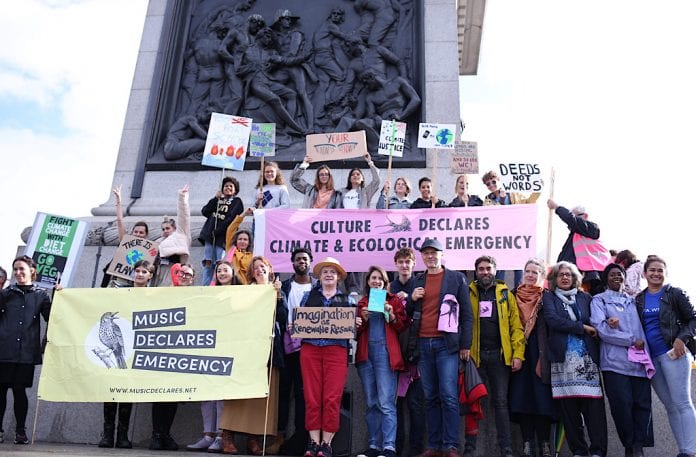Earlier this month, all G7 leaders committed to limiting the global temperature rise to no more than 1.5 °C. Pressure is mounting for the Glasgow COP26 climate summit in autumn to see nations, developed ones particularly, take more immediate climate action.
Culture Declares Emergency (CDE) is one group hoping to increase the pressure and make its mark.
National coordinator Victoria Burns explained the group was set up by an all-women team following the impact Extinction Rebellion began to have in 2019 and a domino effect of UK local authorities subsequently declaring climate emergencies.
It is believed to be the first in a series of declarer movements. Over 1,000 individuals and organisations across the arts and cultural sector have joined CDE by declaring a climate and ecological emergency.
CDE’s Structure
The founders looked to create a cultural sector response to the climate crisis. CDE’s structure is similar to XR’s in allowing for significant independence of its member declarers.
Working groups, or circles, have mandates to help steer goals in particular areas, such as alliance building with other networks or groups, including Black Lives Matter. In turn, a coordination circle is CDE’s main decision-making body, made up of representatives from the other circles. There’s also a mission circle, which includes declarer representatives and meets only occasionally to provide broader agenda setting.
Victoria’s role is “not a leadership position”. Instead, she describes her job as “holding and networking and providing the glue” that binds CDE together. Her duties include managing the declarer database, overseeing the company’s finances, and being the first point of contact for anyone who wishes to become a declarer.
CDE Declarers
UK declarers currently dominate CDE, though it has international pretensions too. Declarers include the BFI, Manchester Museum and the Bristol Old Vic.
Individuals can also declare, and Victoria said this is a “very effective way of creating a tipping point” to persuade an organisation to declare too. One notable individual who has done so is the Angel of the North creator Anthony Gormley.

CDE’s declaration template contains three categories: truth, action and justice. However, its suggestions are advisory—a declarer can craft the declaration according to what suits them best. In the action category, a suggested aim is campaigning for net zero emissions by 2025. Meanwhile, the justice category is based on the climate crisis being created by ‘systemic injustices’ and hurting marginalised people the most.
As Victoria described it, environmental justice and social justice are “inseparable”.
“Melting ice caps and CO2 is a symptom of a particular culture and that culture has been dominated by the global, the northern hemisphere, and a particular way of structuring economics in terms of growth,” she said.
Current Activities
This month, CDE used Twitter to highlight an art installation in St Ives during the G7, run in part by Letters to the Earth. This cultural project also focused on the climate emergency was co-founded in 2019 by CDE along with novelist Anna Hope, theatre director Jo McInnes, and theatre-maker Kay Michael.
The public were invited to write a letter to or from the Earth, other species, future or past generations, or people in positions of power. The likes of Paapa Essiedu and Andrew Scott have performed readings and an illustrated book has been published, highlighting 100 letters from the thousands that were received.
CDE have also reshared work from one of their declarers, Kids in Museums, an organisation that works with museums to make them more child friendly. For over a year, their youth panel has run an Instagram account which tells the story of the climate crisis using objects in museums.
It’s these types of cultural activities that CDE and its declarer members want to increase the number of and their impact, with a strategic action plan developed by the group at the start of the year to help achieve this.
Harnessing Culture’s Power
CDE is not an organisation set up to help fund the cultural sector to switch to more low carbon methods. It is, though, supportive of cultural organisations taking such direct actions. Victoria was keen to emphasise CDE’s promotion of Julie’s Bicycle to members. The not-for-profit was founded in 2007 and has partnered with over 2,000 organisations in arts and culture to encourage more environmentally sustainable practices.
This year marks a turning point for CDE as it moves beyond almost entirely encouraging cultural bodies to declare emergencies. They now seek to harness the power of culture to increase public pressure on major institutions and governments to take more urgent climate and ecological action, and “engage with people’s feelings” to present a more positive vision for the world.
“It’s actually about a culture change, a different way of humans relating to nature and recognise we are part of this ecosystem in a sort of kinder and more regenerative way, not simply sustaining but actually regenerating,” Victoria explained.
Victoria recognised the suggestion may sound woolly at first, but rejected this notion.
“It’s not simply asking people to wave flowers about; as you can imagine, there’s rigorous thought that goes into the work we do.”
“Every art centre or issue practitioner has an audience of their own,” she added. “It’s the amplification effect that we’re really trying to leverage, so you know, if we can get [for example] a museum trust in the north to start engaging their audiences with this sort of thinking, then we have the power to be massively influential.”
As proven in the past, different forms of culture have huge potential to engage the public and trigger action: it was reported that Russell T Davies’ It’s A Sin, charting the onset of the HIV epidemic among gay and bisexual men in the 1980s, helped drive a huge increase in HIV testing.
The cultural sector’s ability to influence public consciousness clearly shouldn’t be underestimated.
CDE could soon be making waves in articulating a brighter, regenerative future through cultural activities such as theatre performances. It is certainly one to watch.
Words by Ivan Morris Poxton
Support The Indiependent
We’re trying to raise £200 a month to help cover our operational costs. This includes our ‘Writer of the Month’ awards, where we recognise the amazing work produced by our contributor team. If you’ve enjoyed reading our site, we’d really appreciate it if you could donate to The Indiependent. Whether you can give £1 or £10, you’d be making a huge difference to our small team.
Featured Image Credit: Talia Woodin
